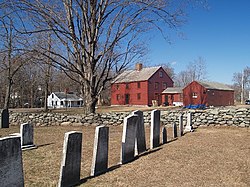
West Boylston is a town in Worcester County, Massachusetts, United States and a northern suburb of Worcester. The population was 7,877 at the 2020 census. West Boylston includes the village of Oakdale, located on the opposite side of the Wachusett Reservoir from West Boylston center along Route 140. Although the town was split off from Boylston, it has a larger population than its eastern namesake.

The E. Albee House is an historic house located at 217 Chapin Street, in Uxbridge, Massachusetts. Probably built in the mid-18th century, it is a well-preserved example of rural vernacular period architecture. On October 7, 1983, it was added to the National Register of Historic Places.

Barlin Acres was an historic house located on what is now East Temple Street in Boylston, Massachusetts. Built in 1734 and eventually transformed into a summer estate house, it was home to a founder of Boylston, and a good example of colonial and Federal period architecture. The house was listed on the National Register of Historic Places on November 26, 1982. It was subsequently demolished to make way for the clubhouse of the Cyprian Keyes Golf Club, which now stands on its site. The clubhouse contains architectural elements recovered from the house, including some flooring and the 19th century Music Room.

The Center Village District encompasses the historic village center of Lancaster, Massachusetts. Settled in 1643, it has few traces of its early history, but is now a well-kept rural town center with a predominantly residential and civic character. It includes the First Church of Christ, Lancaster, which is a U.S. National Historic Landmark, and was listed on the National Register of Historic Places in 1977.
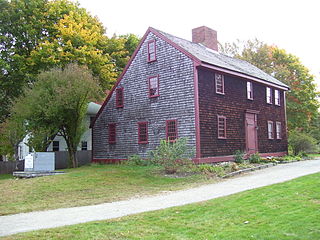
The Parker Tavern is a historic house museum in Reading, Massachusetts, United States. Built in 1694, it is the oldest extant structure in Reading. The saltbox was built by Abraham Bryant, a farmer and blacksmith, and Ephraim Parker operated a tavern on the premises in the 18th century. It has been a local history museum since 1923, and was listed on the National Register of Historic Places in 1975.

The Briggs Tavern is a historic building at 2 Anawan Street in Rehoboth, Massachusetts. Built about 1780 and now used as a private residence, it is the town's only surviving 18th-century commercial building. It was listed on the National Register of Historic Places in 1983.

The Willard-Fisk House is a historic farm property at 126 Whitney Street in Holden, Massachusetts. The farmhouse, built about 1772, is one of the oldest houses in Holden, and one of its oldest brick houses. The property also includes a 19th-century barn and several 20th-century farm outbuildings. The property was listed on the National Register of Historic Places in 1996, where it is listed at 121 Whitney Street.

The Shrewsbury Historic District encompasses the historic early center of the town of Shrewsbury, Massachusetts. It consists of the town common, laid out in 1721 at what are now Main and Prospect Streets, and buildings adjacent or nearby. The district was declared locally in 1972, and was added to the National Register of Historic Places in 1976.
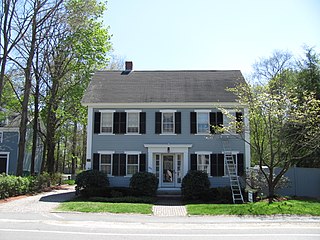
The Inness–Fitts House and Studio is a historic house at 406 Main Street in Medfield, Massachusetts. Built in 1836, it is a modest transitional Federal-Greek Revival structure. Southeast of the house stands a barn, probably built in the mid-18th century, which was adapted c. 1860 by artist George Inness for use as a studio. Inness lived here from 1860 to 1864. The property was listed on the National Register of Historic Places in 2002.

The Bradford Common Historic District is a historic district encompassing the former town center of Bradford, now a village of Haverhill, Massachusetts. Centered on the former town common at South Main and Salem Streets, the area served as Bradford's civic and commercial center from about 1750 until its annexation by Haverhill in 1897, and retains architecture from the 18th to early 20th centuries. It was added to the National Register of Historic Places in 1977.

Hoar Tavern, or the Hoar Homestead, is a historic tavern and house northeast of downtown Lincoln on Reiling Pond Road in Lincoln, Massachusetts. With a construction history dating to 1680, it was for nearly two centuries home to the Hoar family, a prominent legal and political family in Massachusetts. It was listed on the National Register of Historic Places in 1973.

The Samuel Bancroft House is a historic house in Reading, Massachusetts. With an estimated construction date of 1748, it is one of the town's older surviving houses, and one of a small number from the late colonial period. It was listed on the National Register of Historic Places in 1984.
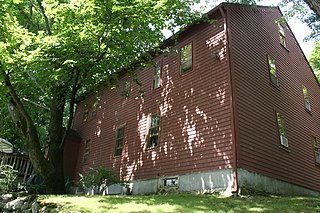
The Benjamin Flagg House is a historic house located at 136 Plantation Street in Worcester, Massachusetts. Built c. 1717, it is considered the oldest structure in the city. It was home to a number of generations of influential Flaggs, including American Revolutionary War Captain Benjamin Flagg (1724–1818). The house was listed on the National Register of Historic Places in 1980.
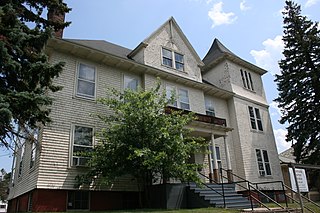
The Greendale Village Improvement Society Building is a historic building at 480 W. Boylston Street in Worcester, Massachusetts. Built in 1897, it is an important reminder of the role community organizations played in making civic improvements in the late 19th and early 20th centuries. It was listed on the National Register of Historic Places in 1976.

The Ezra Rice House is a historic house at 1133 West Boylston Street in Worcester, Massachusetts. It was built sometime between 1833 and 1845, and was a rare local example of transitional Federal and Greek Revival styling. Most of significant exterior details have been obscured or lost due to the application of modern siding. It was listed on the National Register of Historic Places in 1980.
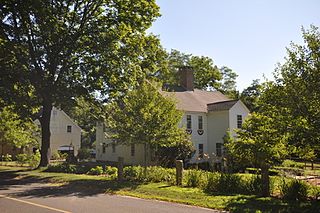
The Peck Tavern is a historic tavern at 1 Sill Lane in Old Lyme, Connecticut. With a construction history that may date to the 17th century, it is one of the town's oldest buildings, and was an important local meeting place in the 18th century. The building was listed on the National Register of Historic Places on April 12, 1982.

The Beaman Memorial Public Library is the public library of West Boylston, Massachusetts. It is located near the town common, at 8 Newton Street, in an architecturally distinguished Colonial Revival building constructed in 1912 to a design by Worcester architect Lucius Briggs. The building was listed on the National Register of Historic Places in 2016.

The Jenks Tavern, also known historically as the East Rupert Hotel and the Hotel G. Jenks, is a historic public accommodations house at the junction of West Dorset Road with Vermont Routes 315 and 30 in Rupert, Vermont. Built about 1807, it is a well-preserved example of an early 19th-century traveler's accommodation in southern Vermont. It was listed on the National Register of Historic Places in 1994. The building is now a private residence, the home of American playwright and author John Nassivera.

The Nichols House is a historic house at the junction of Little John and Waterman Roads, south of the East Barre village of the town of Barre, Vermont. Built in 1799, it is one of the Barre area's oldest surviving buildings, built by one of the town's first settlers. It was listed on the National Register of Historic Places in 1978.

The Fobes-O'Donnell House is a historic house museum at 1221 Old Turnpike Road in Oakham, Massachusetts. Probably built in the second half of the 18th century, it served as a tavern on what was then a major through road, and housed the town's first post office. It is now operated as a museum by the local historical society. The house was listed on the National Register of Historic Places in 2018.
